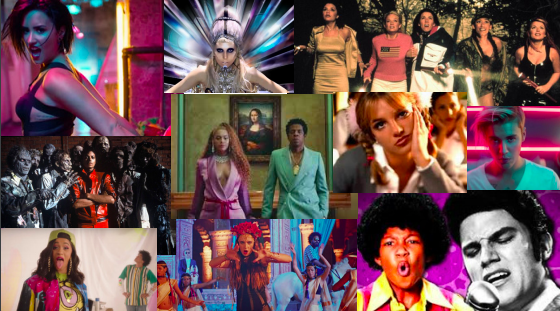Evolution Of Music Videos: How Has The Storytelling Changed?9 min read
Table of Contents
With Halloween around the corner, one can’t help but think about Michael Jackson’s iconic music video ‘Thriller’. Released in 1983, the horror staple song is considered as one of the biggest successes of the music industry. From Jackson’s red jacket to the dancing zombies, everything is etched into the minds of music lovers even after 35 years. It exemplifies the magic that comes to life when the power of music meets the power of visuals. No wonder, the video bagged all the top awards and continues to find itself at the top of ‘greatest music videos’ polls even now.
Thriller reminds us of the time when storytelling became an integral part of creating music. Picturization of the song became as important as the musical notes and tunes. Lady Gaga’s Bad Romance, Beyonce’s Single Ladies, Aerosmith’s Cryin’, and Peter Gabriel’s Sledgehammer are just a few of the many legendary songs that are still remembered for their concepts and choreography besides the good music.
Storytelling through music videos still is an important part of the music industry; although, the narrative has changed. When, why and how, let’s trace the evolution of music videos.
Powerful Visual Storytelling
The music video industry can be divided into ‘Pre-MTV’ and ‘Post-MTV’ period. The modern music videos that we know now came into existence when 24-hour music television channel MTV was launched in the year 1981. The Buggles’ ‘Video Killed the Radio Star’ was the very first music video which was broadcasted on MTV. In the initial few years, the channel didn’t have a bank of videos to play. But gradually the trend of producing videos along with the music started and MTV became a powerful medium to discover new music and artists.
However, there were many events that took place much before MTV’s entry, which contributed to the creation of the term ‘music video’.
American singer Tony Bennett believes that he invented music video in 1953 with his song ‘Stranger in Paradise’. He wrote in his autobiography ‘The Good Life: The Autobiography Of Tony Bennett’, “I filmed what I believe to be the first music video – I was shot walking in Hyde Park along the Serpentine while my recording of “Stranger in Paradise” was played. The clip was distributed to all the local TV stations in the UK and America, where it was aired on shows like Dick Clark’s American Bandstand.”
While some believe that talkies, sheet music, soundies, musical short films and musical films that existed between the early 1890s and late 1950s were the actual predecessors of music video.
According to Rolling Stone, it was Queen’s Bohemian Rhapsody that invented music videos. It was the success of this song’s promotional clip that compelled record companies to pay attention to videos as a way to market new releases and increase sales.
Whether it was the talkies, Bennett or Queen, the fact of the matter is that each of these milestones played a crucial role in preparing the world for the post-MTV era. Singers became performers, and entertainers. Synchronized one-dimensional dancing videos turned into high-production value short movies. Immersive audio and video experience is what artists started to offer through music videos to their listeners. And Michael Jackson’s body of work is one of the biggest examples of it.
When Jackson talked about the making and conceptualization of ‘Thriller’, he didn’t call it a music video; he called it a short movie instead. “My idea was to make this short film with conversation … I like having a beginning and a middle and an ending, which would follow a story,” Jackson said in an interview while talking about Thriller.
How Brands Harnessed The Power Of Music Videos?
In the 1980s and the 1990s, the revenue generated from the sale of albums and concerts tickets were the primary source of income for music creators and producers. But the music programming industry witnessed a dip in sales during the early 90s. MTV shifted its focus from music shows to reality shows and thus ended the golden period of the 24-hour music channel.
Things changed in 2005 when American video-sharing website YouTube made its debut. The music video industry was revived in that year, and since then it has grown from strength to strength.
With its revival, came product placements. The world of branding and advertising seeped into music videos. And it helped music producers to generate an alternate source of revenue. Brands also immensely benefited from it as they realized the reach of music artists and their videos.
Let’s go back to Michael Jackson’s Thriller. It holds the record of number one best-selling album with 62 million copies sold (claimed sales). On YouTube, the official video has garnered 542 million views! It has no product placements as it was made at the time when the concept didn’t exist.
But the opportunity of monetizing music videos exists now. Therefore, it doesn’t come as a surprise that brands want their share of fame; even it means paying bags full of money just for a few minutes (or seconds) in a music video. In addition, placements in music videos are not time sensitive like TV shows or movies. People stream their favourite music over and over again. If it features top artists, then brands can see a steady stream of revenue being generated from an investment they made 5 or 10 years ago.
Lady Gaga’s 9 and a half minute video ‘Telephone’ has not one but twelve brand placements, with Diet Coke, Virgin Mobile, Monster Heartbeats and Miracle Whip being some of them. This 9 minute video got the featured brands noticed by over 296 million people.
Mercedes and Adidas were able to reach 3.2 billion viewers by placing their products in the 2012 released surprise hit PSY’s Gangnam Style. It would be safe to assume that with good visibility came good revenue.
“In a new study, Nielsen found that not only do people notice brands in music videos, but these videos can contribute to a lift of 8 percentage points, on average, in purchase intent and improved perception. Even in the cases where the brand product placements weren’t as noticeable, overall awareness increased. In essence, these videos can present a more organic alternative to a blatant endorsement, which can be less effective with certain music genres,” a Nielsen report stated.
With more brands and artists maximizing revenue on their videos, new technology in video making is taking over.
Read about these 6 Things You Need To Be Doing With Your Brand’s Videos ASAP
The Impact of Digital Age
The next curve of growth in the music video industry life cycle became visible in the last five years due to the advent of social media and technology. The moulds of conventional collaboration between an artist and a brand are getting broken every day. And what’s growing in its place is an environment that thrives on creativity, smart use of technology, commentary on culture and rich visual language.
Case in point: Pharrell Williams’ viral song ‘Happy’. It started as a soundtrack for the movie Despicable Me 2. The song became a massive hit across the world and 100s of tribute videos were uploaded on YouTube. The end result – the movie became one of the highest grosser of 2013 because of its association with Williams’ song.
Canada-based fashion company Ssense collaborated with music artists Iggy Azalea Diplo and FKi to release an interactive shoppable video. In 2015, Grammy-winner artist The Weeknd released ‘The Hill’ music video that offered a virtual reality experience, courtesy GoPro.
This has opened new channels for brands to market their products in creative ways. A decade ago it would have been impossible to imagine that a tech product can be advertised by showing the ‘experience’ and not necessarily the product. But GoPro did it by creating a 360-degree music video and promoting it via a hugely popular music performer The Weeknd.
Are Brand Placements Going Out of Hand?
Gaga’s Telephone was heavily criticized for the sheer number of brand placements and how they were presented. At one point in the video, she can be seen wearing Diet Coke cans as hair rollers. This brings forth the alarming shift in the narrative when it comes to storytelling.
Earlier, the music and the artists were at the centre stage and product placement was secondary and seamless. Now, it is becoming too in-your-face and some brands like Beats by Dr.Dre are overdoing it.
It would be wrong to believe that the issue can be fixed by reducing/restricting the number of brands in one video. Primarily because multiple brands are not the main issue. For instance, in Ariana Grande’s ‘Focus’, Samsung Galaxy is the brand that is featured prominently. But the song’s theme ‘galaxy’ and the over-presence of the phone didn’t sit well with the viewers.
A song with a story might require hundred different things. The problem starts when brands are not seamlessly infused or have no place within the story and therefore, stick out like a sore thumb.
Understanding Creative Partnerships
The 24-hour viewing figure of every single video of music artists like K-pop band BTS, Taylor Swift and Adele are record-breaking. BTS’s Fake Love’s 24-hour viewing figure was 35.9 million and now it has over 327 million views. USA’s population is 327.16 million. Therefore, it would be unwise to not take advantage of such an amazing marketing opportunity.
However, emphasis should be placed on inserting brands into videos only where relevant. And it can only happen when performers value their personal brand more than the endorsements. There are budding artists like Ella Mai who admit that the extra money through brand placements helps because producing a video is a costly affair. On the other hand, there are celebrated performers like Beyonce who often voluntarily plugs businesses/brands. In her ‘Formation’ song, she casually mentioned Red Lobster seafood chain and the restaurant’s sales increased by 33%!
Technology allows experimenting, getting creative and creating an interactive experience; so there’s no room for lazy storytelling. Focus should be on understanding partnerships, endorsements, and placements. A music video can have 10 paid brands like Gaga, 1 like Mai or zero like Beyonce, if the driving force behind the narrative doesn’t affect the music’s soul.
With smart technology enabled syndications, brands and stars today are taking these collaborations to a whole new level. From taking brand endorsements from promotions to the add-to-cart page, video enabling solutions today are closing the loop on collaborations benefits all parties involved.






